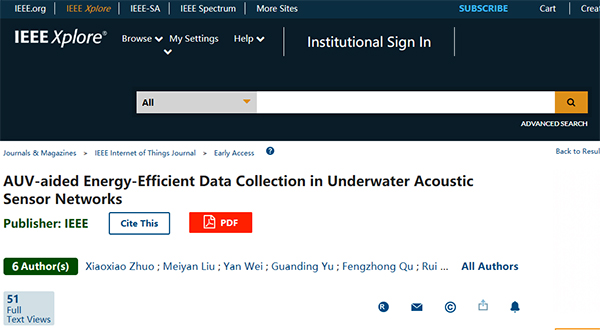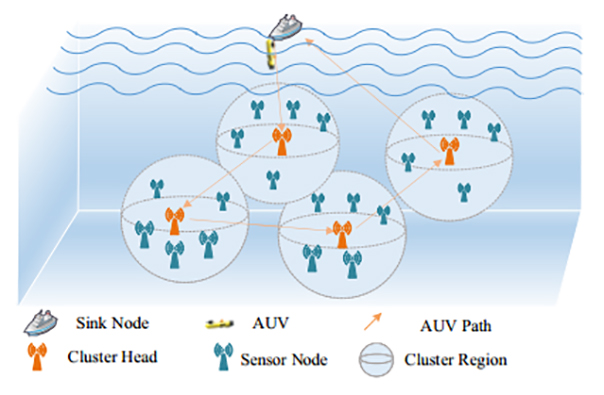NEWS
Direct doctoral students of ocean college publish research results in IEEE Internet of things Journal
The Key Laboratory of Zhejiang ocean observation imaging experimental area of Ocean University has made important progress in the research of AUV assisted energy efficiency optimization algorithm for underwater acoustic sensor network Network , with Zhuo Xiaoxiao, a direct doctoral student of ocean college in 2017, as the first author, recently published online in IEEE Internet of things Journal (if: 9.936).

The Internet of underwater things (IOUT) is defined as the interconnection network of underwater agents, which is regarded as one of the most important technologies in the intelligent ocean. Compared with electromagnetic wave and light wave, underwater acoustic wave has smaller attenuation and longer propagation distance, which is considered as the most suitable medium for underwater reliable long-distance communication. Therefore, underwater acoustic sensor networks (UWSN) has become an indispensable part of IOUT, and plays an important role in marine environmental monitoring, marine science, marine resources development, equipment control and navigation, and military. In these applications, a large number of sensor nodes equipped with underwater acoustic communicators are intensively deployed to collect data and send it to the receiving nodes (such as buoys) connected to the land data center. However, in the current stage of the development of underwater acoustic communication machine, to establish such a UWSN with large-scale communication, long-term monitoring and high data traffic load demand is limited by the communication distance and energy consumption of underwater acoustic communication machine. Therefore, how to design an effective mechanism to collect and transmit data is an urgent task.
With the development of autonomous underwater vehicles (AUV), data collection assisted by underwater mobile nodes is an effective method. Because AUV embeds the functions of data collection, storage and computing services, they can play the role of organizing and managing the network and sharing the burden of computing. In UWSN, AUV will travel around to visit fixed sensor nodes and collect data from them, which helps to save the transmission energy of sensor nodes due to the short transmission distance. However, due to the slow speed of AUV, this solution also introduces long collection latency and low throughput. Therefore, in AUV assisted UWSN, the main problem is to trade-off between energy consumption and network throughput. In order to deal with these challenges, we should not only plan the path of AUV to reduce its cruise time, but also carefully establish the network model to optimize the network performance.
This paper proposes an AUV assisted energy efficiency optimization algorithm for underwater acoustic sensor networks. The network energy consumption and throughput utility factors are defined as the optimization objectives. According to the energy consumption model and communication constraints of nodes, the constraint conditions are established, the clustering network topology is established, the underwater acoustic communication media access control protocol is designed, and the path of mobile nodes is planned. The simulation results show that the algorithm has good performance in throughput, delay and energy consumption. Furthermore, in order to solve the problem of excessive computational complexity, another heuristic algorithm is used to make a trade-off, which can reduce the complexity and obtain approximate performance results.

AUV辅助的水声数据收集网络模型
The research was carried out under the guidance of Professor Qu Fengzhong, School of Oceanography, Zhejiang University, and also under the guidance and support of Associate Professor Wei Yan, School of Oceanography, Zhejiang University, Professor Yu guanding, School of information and electronics, Zhejiang University, and associate researcher sun Rui, Nanjing University of Aeronautics and Astronautics; the research was supported by the outstanding youth science foundation of National Natural Science Foundation of China and Zhejiang Provincial Natural Science Foundation of China It is supported by the key projects of the integration of industrialization and industrialization foundation of China, the National Natural Science Foundation of China, and the cooperation projects between Zhoushan and Zhejiang University.

